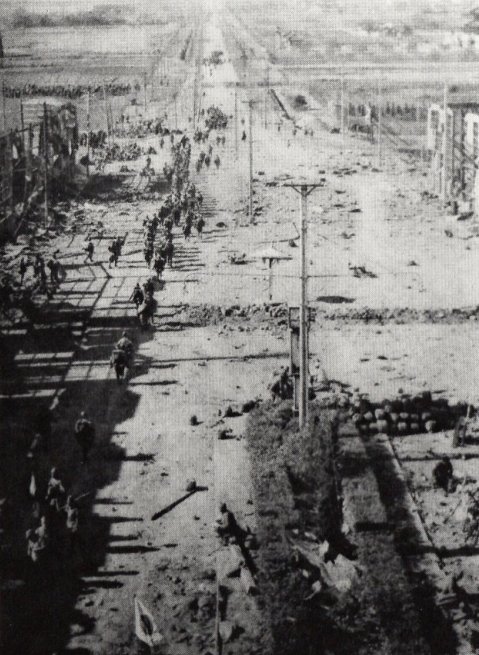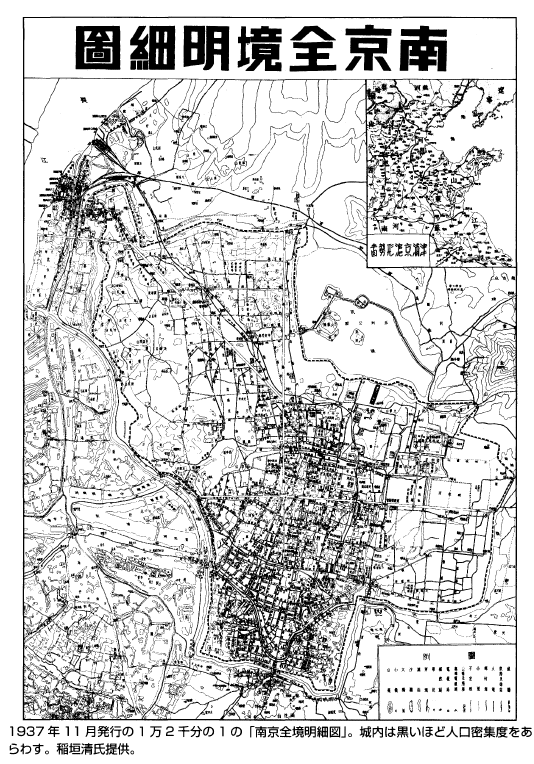
The following photo is found in p.124 of gThe Core of the Nanking Incident (uìÌjSv) g authored by TOMIZAWA Shigenobu (yàVÉM). It shows the Confucius Temple called gFu Tze Miaoivq_j.h The caption of the photo says it was taken on February 20 by correspondent OKA.
The location of the temple is indicated in the following map as the area encircled by the red rectangle
.
February 20 is the 69th day since the fall of Nanking, which is December 13, 1937. The photo appears to show Chinese New Year Spring Festival.
From the photo, you will notice that:
- It was taken after approximately 70 days since the fall of the city.
- People enjoy shopping and seem to be relaxed. There is no feeling of fear or emergency shown from their appearance.
- Rickshaw service had recovered by this time, and Nanking citizens could go almost all the area within the city, probably less than half a day.
Compare the photo with the map of "The Rape of Nanking" (by Iris Chang) and find where the massacre allegedly have had taken place. The book suggests that, in addition to the areas along the Yangtze River, outside the city, and along the city-walls, massacre(s) had also occurred in close vicinity to the Confucius Temple.
It is well known that the defending Chinese Army had burned down buildings and obstructions in towns in a 10 mile radius of Nanking in order to secure the field of fire before arrival of the Japanese Army. It is simply unimaginable that so many civilians were so widely dispersed in such a wide expanse of the area, without evacuation from the anticipated war zone.
Some scrutiny, therefore, will be necessary.
gWhat War Meansh (by Harold J. Timperley) writes as follows:
gIt is to be noted that the incidents thus recorded cover only the Nanking Safety Zone, and that the rest of Nanking was practically deserted until the end of January and most of the time was without foreign observers during the whole period.h (p.143, the first page of Appendix A)
The following view from the East Gate (Chungshan Gate) taken on the fall of the city (Dec.13, 1937) seems to corroborate Timperleyfs description.
As the map on the right shows, Nanking City in 1937 was divided into densely populated area (with many black dots) and sparsely populated area (with few black dots).
Besides, according to the cable sent by New York Times correspondent Tillman Durdin on December 8, gThe Nanking defense commander, Tang Sheng-chih, proclaimed the city within the zone of hostilities and decreed that all noncombatants must concentrate in the internationally supervised safety zone. The movement of noncombatants elsewhere in the city will be banned, except for persons holding special permits to be indicated by a symbol specially stamped on yellow arm bands.h John Rabefs statement in his letter to the Japanese Embassy dated December 17, which says, gIn other words, on the 13th when your troops entered the city, we had nearly all the civilian population gathered in a Zone,h corroborates the situation.
This means, all non-combatants were concentrated in the Safety zone and no civilians were allowed to go outside the Zone by the time the Japanese Army commenced attack on December 10. John Rabefs statement in his letter to the Japanese Embassy dated December 17, which says, gIn other words, on the 13th when your troops entered the city, we had nearly all the civilian population gathered in a Zone,h corroborates the situation.


Then, we would have a big question. If the description of gWhat War Meansh is true, what is the basis of Iris Chang's claim of gsites of massacre h as indicated with X in the map of gRape of Nankingh where, except for the Nanking Safety Zone, gthe rest of Nanking was practically desertedh? No man can commit any massacre in the place "practically deserted."
Some people say that gThe Nanking Massacre is well-documented.h
If so, how can they explain the peaceful scene of the Comfucius Temple? The photo clearly demonstrates the recovery of law and order within the city of Nanking by February 20, 1938.
Wellc, if the Nanking Massacre is well-documented, it must be most well-documented in the verdict of gThe International Military Tribunal for the Far Easth (hereinafter referred to as gTokyo Trialh).
The virdict says as follows:
All resistance had ceased as the Japanese Army entered the city on the morning of 13 December 1937. The Japanese soldiers swarmed over the city and committed various atrocities. According to one of the eye witnesses they were let loose like a barbarian horde to desecrate the city. ccc. Individual soldiers and small groups of two or three roamed over the city murdering, raping, looting and burning. There was no discipline whatever. Many soldiers were drunk. Soldiers went through the streets indiscriminately killing Chinese men, women and children without apparent provocation or excuse until in places the streets and alleys were littered with the bodies of their victims. According to another witness Chinese were hunted like rabbits, everyone seen to move was shot. At least 12,000 non-combatant Chinese men, women and children met their deaths in these indiscriminate killings during the first two or three days of the Japanese occupation of the city. ccc. Approximately 20,000 cases of rape occurred within the city during the first month of the occupation. ccc. Estimates made at a later date indicate that the total number of civilians and prisoners of war ordered (to kill) in Nanking and its vicinity during the first six weeks of the Japanese occupation was over 200,000. That these estimates are not exaggerated is borne out by the fact that burial societies and other organizations counted more than 155,000 bodies which they buried.Please note the part that says gduring the first six weeks of the Japanese occupation" of the city.
The verdict of General MATSUI Iwane, commander of the attacking Japanese Army, also says, "The orgy of crime started with the capture of the City on the 13th December 1937 and did not cease until early in February 1938."
Should the verdict actually reflect the situation of Nanking after its fall to the Japanese Army, there should have been piles of bodies everywhere in early February 1938. People should have been frightened of the eerie and dreary atmosphere and most probably, they were in the process to evacuate the city in great haste due to the fear of the immediate danger. However, the photo taken on February 20 does not show any such tension in the Nanking citizens walking and enjoying shopping on the streets near to the Confucius Temple.
gThe Rape of Nankingh (by Iris Chang) also writes, gThe Rape of Nanking continued for months, although the worst of it was concentrated in the first six or eight weeks.h (p.159)
How come?
We all know the faces of the boat people after the fall of Saigon to the Viet Cong and those of Syrian refugees displaced from their homes.
Why no such fear and anxiety can be seen on the faces of the Nanking citizens in the photo?
All these will make you go down to the truth: The Nanking Massacre was and is hoax and Tokyo Trials falsely accused innocent persons including General MATSUI. General MATSUI's death by hanging was a judicial murder.


|
|
To the top of this page |
|
|
Return to Home |